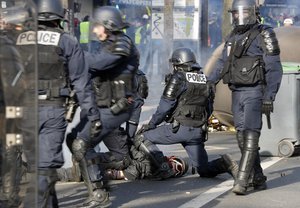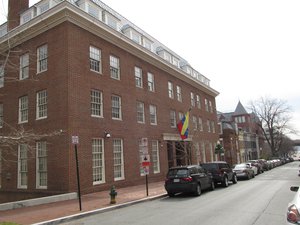Executive arrangements
In England, local authorities are required to adopt one of three types of executive arrangements, which govern how decisions will be made within the council. Before the adoption of the Localism Act 2011 there were two principal modes of executive arrangement. They are the "leader and cabinet" and "elected mayor and cabinet" models. A third option "elected mayor and council manager" was withdrawn in 2007. Since 2012, principal authorities have been allowed to return to the "Committee system".
Leader and cabinet
The leader and cabinet model was introduced following the Local Government Act 2000.
It consists of the leader and the cabinet itself, which is usually formed by the majority party in the local authority, where there is one, or by a coalition which comes together to elect a leader. The council elects the leader, and the leader appoints the other members of the cabinet. Each cabinet member holds a separate portfolio, such as housing, finance, economic development, or education. Decisions may be delegated to the individual members, or taken by the cabinet as a whole. These decisions are scrutinised by one or more scrutiny committees, which may be dedicated to one or more service areas.
Executive
Executive may refer to:
- Chief executive officer (CEO), one of the highest-ranking corporate officers (executives) or administrators
- Executive director, the senior manager of an organization, company, or corporation
- Executive education, term used for programs at graduate-level business schools that aim to give classes for managers or entrepreneurs
- Executive officer, high-ranking member of a corporation body, government or military
- Business executive, a person responsible for running an organization
- Music executive or record executive, person within a record label who works in senior management
- Studio executive, employee of a film studio

Executive (government)
The executive is the organ that exercises authority in and holds responsibility for the governance of a state. The executive executes and enforces law.
In political systems based on the principle of separation of powers, authority is distributed among several branches (executive, legislative, judicial) — an attempt to prevent the concentration of power in the hands of a small group of people. In such a system, the executive does not pass laws (the role of the legislature) or interpret them (the role of the judiciary). Instead, the executive enforces the law as written by the legislature and interpreted by the judiciary. The executive can be the source of certain types of law, such as a decree or executive order. Executive bureaucracies are commonly the source of regulations.
In the Westminster political system, the principle of separation of powers in not as entrenched. Members of the executive, called ministers, are also members of the legislature, and hence play an important part in both the writing and enforcing of law.
Executive officer
An executive officer (often abbreviated XO) is generally a person responsible for running an organization, although the exact nature of the role varies depending on the organization.
Administrative law
While there is no clear line between executive or principal and inferior officers, principal officers are high-level officials in the executive branch of U.S. government such as department heads of independent agencies. In Humphrey's Executor v. United States, 295 U.S. 602 (1935), the Court distinguished between executive officers and quasi-legislative or quasi-judicial officers by stating that the former serve at the pleasure of the president and may be removed at his discretion. The latter may be removed only with procedures consistent with statutory conditions enacted by Congress. The decision by the Court was that the Federal Trade Commission was a quasi-legislative body because of other powers it had, and therefore the president could not fire an FTC member for political reasons. Congress can’t retain removal power over officials with executive function (Bowsher v. Synar). However, statutes can restrict removal if not purely executive (Humphrey’s executor), but can't restrict removal of purely executive officer (Myers v. United States, 272 U.S. 52 (1926)). The standard is whether restriction "impedes the president’s ability to perform his constitutional duty" (Morrison v. Olson, 487 U.S. 654 (1988)).
Executive arrangements
In England, local authorities are required to adopt one of three types of executive arrangements, which govern how decisions will be made within the council. Before the adoption of the Localism Act 2011 there were two principal modes of executive arrangement. They are the "leader and cabinet" and "elected mayor and cabinet" models. A third option "elected mayor and council manager" was withdrawn in 2007. Since 2012, principal authorities have been allowed to return to the "Committee system".
Leader and cabinet
The leader and cabinet model was introduced following the Local Government Act 2000.
It consists of the leader and the cabinet itself, which is usually formed by the majority party in the local authority, where there is one, or by a coalition which comes together to elect a leader. The council elects the leader, and the leader appoints the other members of the cabinet. Each cabinet member holds a separate portfolio, such as housing, finance, economic development, or education. Decisions may be delegated to the individual members, or taken by the cabinet as a whole. These decisions are scrutinised by one or more scrutiny committees, which may be dedicated to one or more service areas.
Latest News for: executive arrangements
Planners tell man he can’t keep a 15ft cannon in his garden
Flushing Financial Corporation to Meet With Institutional Investors
 Omaha World-Herald
07 May 2019
Omaha World-Herald
07 May 2019
GM’s self-driving car unit pulls in $1 billion in race to launch ride-hailing service
 The Los Angeles Times
07 May 2019
The Los Angeles Times
07 May 2019
Sierra Leone’s economic growth may hit 5.1% as inflation soars at 17.5% – says IMF
Man accused of igniting explosive before arrest by two FBI task force officers defends himself at trial
Preparations in full swing for 9-day annual Brahmotsavams
Uganda, Cameroon most affected by road traffic deaths, injuries in Africa: ECA
After CBS2 Report On Litter On ‘Sponsored’ Highways, Nassau County Leaders Promise Action
LeoSat’s Commercial Traction Accelerates to Hit US$2Billion Milestone
 Daily Freeman
06 May 2019
Daily Freeman
06 May 2019
- 1
- 2
- 3
- 4
- 5
- Next page »





































